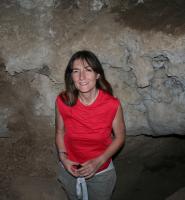Fernández Jalvo Yolanda
- Investigadora Científica
- Jefe de departamento
- Departamento: Paleobiología
- Dirección física: Calle del Pinar 25
- Teléfono: 914111328 ext. #443483
- Email: yfj@mncn.csic.es
- Página web externa: https://www.mncn.csic.es/es/quienes_somos/fernandez-jalvo-yolanda
- Número ORCID: 0000-0002-1089-7136
- Palabras clave:

Investigación
My contribution to the field of taphonomy and anthropology is threefold. On the one hand, studies related to research involving human behavior and social strategies. Secondly, site formation and research on histotaphonomy, microbiology, preservation/transformation of organic and inorganic bone components (e.g., collagen, DNA, hydroxyapatite). Thirdly, interpretations of past environments, ecosystems and climates. This diverse and transversal research has allowed me to participate with a great diversity of projects and research groups in Paleontology (evolution and human behavior, taxonomy, palynology, paleoclimatology, palaeogenetics, palaeoenvironments and palaeoecology, paleoclimatology), animal ethology, histology-histotaphonomy, forensic research and health medicine.
The status of Taphonomy in the scientific scenery of Paleobiology and Paleoanthropology gives special relevance to Taphonomy, because this is a transversal research between taxonomic and geography-geological time, allowing me to participate at the Palaeoanthropological Group of CSIC as team member, and obtaining join projects with members of the Palaeobiology Department of the MNCN (such as M.T.Alberdi on Global Palaeo-Climatic Changes: CGL2021-126933NB-I00). Therefore, I have join projects with members of one and the other groups. In fact, Taphonomy is also transversal with other investigations, such as geology, palaeogenetics, environmental studies, past ecosystem interpretations, as well as Forensic studies, histology and even health. The interest and application of taphonomic principles, experiments and protocols are not only common in Forensic studies, but also applied to other disciplines and investigations, such as health and handmade objects. The limit of taphonomy is a question of applicability. So far, knowledge could at some extend be applied to interpret how these objects (bone or human-made tools) arrived to our times and which processes allowed them to survive. In this respect, our Laboratory of Experimental Taphonomy (now Laboratory of Environmental Analyses and Taphonomy): https://www.mncn.csic.es/en/investigaci%C3%B3n/servicios-cientifico-tecnicos/laboratory-environmental-analyses-and-taphonomy-leat applied to different objects and objectives. This laboratory is like a "fossils in the making" to reproduce the most intriguing processes in the long history of life forms i.e. fossilization: a combination of physical and chemical conditions which preserved past life forms until today. However, despite this laboratory originates with the Taphonomic Research Group of the MNCN, research has extended not only to large and small mammal fossil bones, but also to pollen (also referred to allergies and asthmatic illness) and a variety of samples of different nature such as shells, seeds, feathers, hair, leather, coal, lithic artefacts or even building materials, industrial paintings, ceramic, prosthetic materials, plastics, cellulose, glass, pigments, textiles, resins, or paper.
Otros investigadores del departamento
- Aida Gutiérrez
- Alba Macho-Callejo
- Alberdi Alonso María Teresa
- Antonio Rosas
- Bastir Markus
- Caballero Chordá Óscar
- Carlos A. Palancar
- Daniel Garcia Martinez
- Daniel Sanz Prieto
- Darío Fidalgo Casares
- Fabien Knoll
- García Tabernero Antonio
- Gema Siliceo
- José M. López-Rey
- López Cantalapiedra Juan
- Marta Gómez Recio
- Martín Perea David Manuel
- Miguel López Cano
- Morales Romero Jorge
- Pelaez-Campomanes de_Labra Pablo
- Pesquero Fernández María Dolores
- Rodrigo Córdoba Clara
- Salesa Calvo Manuel Jesús
- Sara Garcia Morato
- Van der Made Jan





